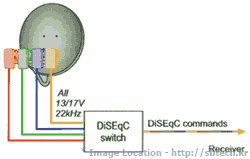본문
What is DiSEqC?
DiSEqC is an open standard that stands for Digital Satellite Equipment Control.

DiSEqC is an open standard that stands for Digital Satellite Equipment Control.

Why DiSEqC?
In order to squeeze more channels into a given frequency band width, channels are transmitted with vertical OR horizontal polarisation.
The conventional LNB known as the "Marconi (polarisation) Switching LNB" responds to the supply voltage to change the polarisation. If the supply voltage going up the dish cable is less than 15 volts, the LNB will "see" only vertically polarised transmissions. If the voltage is more than 15 volts, it will "see" only horizontally polarised transmissions.
The older type of LNB had a separate polariser to do this job and was able to use the voltage to select High Band or Low Band operation (by changing the internal oscillator frequency).
So the modern LNB has a problem if it has to switch between two frequency bands. The problem was overcome with the introduction of the "Universal" LNB.
The "Universal" LNB switches polarisation with voltage but it also switches its internal oscillator for "High Band" when it "hears" a 22kHz tone. Specificallly, the oscillator changes from 9.75 GHz to 10.6 GHz.
Recently manufactured receivers incorporate a 22kHz tone generator which is menu-selectable on a per-channel basis. (One exception is the Ferguson SRD6 which has a tone generator but no menu selection. The tone comes on automatically if you program a channel for a higher frequency).
Older receivers require an external tone generator box in order to make the "Universal" LNB select High Band. The external box can be controlled by a manually operated switch or by some feature of the receiver which will put a voltage onto its control wire to switch it on.
An alternative use for the 22kHz tone is to control an external switching box whichfeeds signals from one of a pair of LNBs into the receiver. For example, you could have two separate LNBs on a dish connected to a switching box which is itself connected to the receiver by a single coaxial cable. When the box "hears" a 22kHz tone it swaps to the other LNB.
DiSEqC is an extension of this idea. It relies on a switching box which detects the 22kHz tone pulsing rapidly on and off. In this way, a specially designed receiver can control numerous LNBs through a DiSEqC switching box.
How DiSEqC Works
DiSEqC messages are sent as sequences of short bursts of 22KHz tone modulated on the LNB power supply carried by the coax cable from the LNB input on the receiver (the master). Messages comprise a number of digital bytes of eight bits each. Each bit occupies a specific time and teh proportion of that time filled with the 22KHz burst determines whether that bit is a 1 or a 0.

The first byte is the Framing byte. The first five bits in this follow the pattern, '11100' to allow listening devices (slaves) to synchronise to the signal. Some of these may change with later versions of DiSEqC. The sixth bit is set to 0 if the message is a command from the master or 1 if it's a reply from a slave. Bit seven is set to '1' if a response is required or 0 if not. The last framing bit signals whether this message is a re-transmission of a message for which a reply has not been received.

The second byte indicates which family of devices the message is for. The first half (four bits) indicates the type of device (LNB, switch, positioner etc) and the second half the particular type. In each half of this Address byte a value of 0 means the message is open to all.
Next comes the Command byte. This actually tells the listening devices what to do. This is followed by a number of Data bytes to pass on numbers relevant to the command (such as the angle required from a separate polariser).
For control of simple mini-DiSEqC switches, one of two tone bursts, generated with a sequence of nine DiSEqC '1' bits and a 12.5ms burst of 'raw' 22KHz tone.

DiSEqC applications
DiSEqC system has been designed primarily to meet the problem of two-satellite, two-band systems with ease. It has dedicated outputs to select polarity, satellite position and frequency band.
The option output can be used along with the satellite position output to select up to 4 LNBs on a multi-feed system.
※ 출처 - http://www.techtronics.com
추천 0

